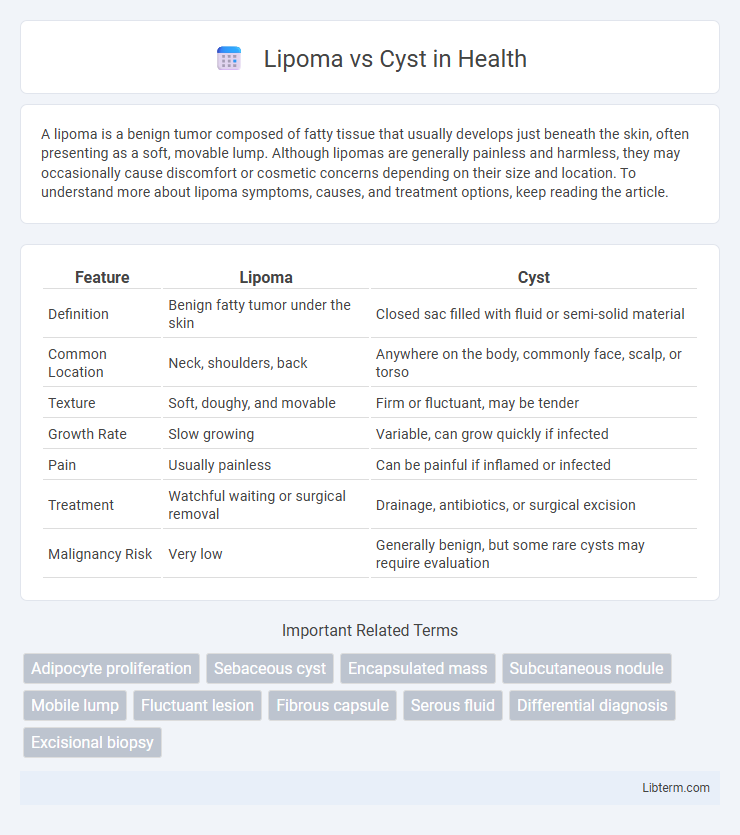A lipoma is a benign tumor composed of fatty tissue that usually develops just beneath the skin, often presenting as a soft, movable lump. Although lipomas are generally painless and harmless, they may occasionally cause discomfort or cosmetic concerns depending on their size and location. To understand more about lipoma symptoms, causes, and treatment options, keep reading the article.
Table of Comparison
| Feature | Lipoma | Cyst |
|---|---|---|
| Definition | Benign fatty tumor under the skin | Closed sac filled with fluid or semi-solid material |
| Common Location | Neck, shoulders, back | Anywhere on the body, commonly face, scalp, or torso |
| Texture | Soft, doughy, and movable | Firm or fluctuant, may be tender |
| Growth Rate | Slow growing | Variable, can grow quickly if infected |
| Pain | Usually painless | Can be painful if inflamed or infected |
| Treatment | Watchful waiting or surgical removal | Drainage, antibiotics, or surgical excision |
| Malignancy Risk | Very low | Generally benign, but some rare cysts may require evaluation |
Introduction to Lipoma and Cyst
Lipomas are benign tumors composed of fatty tissue, typically found just beneath the skin and presenting as soft, movable lumps. Cysts are fluid-filled sacs that can develop in various tissues, characterized by a defined membrane and potential for swelling. Both conditions are generally noncancerous but require differentiation for appropriate treatment.
Understanding Lipoma: Definition and Characteristics
A lipoma is a benign tumor composed of mature fat cells, typically soft, movable, and painless, often found just beneath the skin. Unlike cysts, which are fluid-filled sacs, lipomas are solid masses that grow slowly and rarely cause discomfort. Recognizing their smooth, rubbery texture and common locations on the neck, shoulders, back, or arms helps in distinguishing lipomas from cysts and other skin abnormalities.
Understanding Cyst: Definition and Characteristics
A cyst is a closed sac-like structure filled with fluid, semi-solid, or gaseous material that can develop anywhere in the body, often beneath the skin. It is typically benign, slow-growing, and may cause discomfort or swelling depending on its size and location. Unlike lipomas, which are composed of fatty tissue, cysts often arise from blocked glands or infections, characterized by a distinct capsule lining that differentiates them from other soft tissue masses.
Key Differences Between Lipoma and Cyst
Lipomas are benign tumors composed of fatty tissue, typically soft, movable, and painless, while cysts are sac-like structures filled with fluid, semi-solid, or gaseous material that can sometimes become inflamed or infected. Lipomas usually develop slowly beneath the skin and rarely cause discomfort, whereas cysts may cause pain or tenderness, especially if infected. Diagnostic imaging like ultrasound or MRI helps differentiate lipomas from cysts by revealing their internal composition and structure.
Causes of Lipoma vs Causes of Cyst
Lipomas primarily develop due to genetic factors and abnormal growth of fat cells, often linked to hereditary conditions or minor injuries that trigger fat cell proliferation. In contrast, cysts commonly form from infections, blocked sebaceous glands, or chronic inflammation causing fluid or semisolid material to collect in a sac-like structure. The underlying mechanisms of lipoma involve benign adipose tissue tumors, while cyst causes revolve around cellular blockages, infections, or skin trauma leading to encapsulated fluid accumulation.
Common Symptoms: Lipoma vs Cyst
Lipomas typically present as soft, painless, and slow-growing lumps beneath the skin, often movable and without redness or warmth. Cysts commonly appear as firm or rubbery lumps that may be tender, sometimes accompanied by redness, swelling, or fluid drainage if infected. Both conditions can vary in size but lipomas generally remain asymptomatic, whereas cysts may cause discomfort or inflammation.
Diagnosis: How to Differentiate Lipoma from Cyst
Diagnosis of lipoma versus cyst primarily relies on clinical examination and imaging techniques. Lipomas are soft, movable, and typically painless masses composed of fatty tissue, while cysts are fluid-filled sacs that can sometimes become tender or inflamed. Ultrasound imaging and MRI scans help distinguish lipomas by revealing homogenous fat content, whereas cysts appear as fluid-filled cavities with different echogenicity.
Treatment Options for Lipoma and Cyst
Treatment options for lipomas primarily include surgical excision and liposuction, which effectively remove the fatty tumor with minimal recurrence risk. Cysts are commonly treated through drainage or surgical removal, with techniques varying based on cyst type, such as epidermoid or sebaceous cysts. Both conditions may also respond to corticosteroid injections to reduce inflammation or size before definitive excision.
When to Seek Medical Attention
Seek medical attention for a lipoma if it grows rapidly, becomes painful, or changes in texture, as these symptoms could indicate malignancy. For cysts, consult a healthcare provider if the cyst becomes red, swollen, or tender, signifying possible infection or rupture. Persistent discomfort, changes in size, or unusual symptoms associated with either condition warrant prompt medical evaluation to rule out complications.
Lipoma vs Cyst: Prevention and Recurrence
Lipomas are benign fatty tumors that rarely require prevention, as their cause is often unknown and linked to genetic predisposition, whereas cysts, fluid-filled sacs, can sometimes be prevented by maintaining good hygiene and avoiding skin trauma. Recurrence rates differ; lipomas typically do not recur after surgical removal, while cysts have a higher chance of returning if the entire sac is not completely excised. Proper medical evaluation and treatment are essential for both to minimize recurrence and manage any associated symptoms effectively.
Lipoma Infographic

 libterm.com
libterm.com